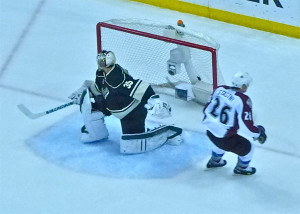Wild Go…Wild, to Force Game 7
By John Gilbert
The Minnesota Wild stretched their Stanley Cup Playoff series to a seventh game with a fantastic finish to Game 6 Monday night, blowing a 2-goal lead, but regaining their sharpness — thanks to a brilliant strategic move by coach Mike Yeo — just in time to break the 2-2 tie and seal a 5-2 victory with two empty-net goals.

Jason Pominville showed relief as well as elation as Minnesota Wild teammate Erik Haula chased him to celebrate his empty-net goal in Game 6 against Colorado.
Everything that happened in the last seven minutes of that Game 6 had significance. Even the two empty-net goals, by Jason Pominville and Marco Scandella, because twice earlier in the series the Wild let victories get away when Avalanche coach Patrick Roy pulled goaltender Semyon Varlamov with over two minutes left and his team responded with goals that led to overtime victories over the Wild.
“We were about due for a few empty-netters,” said goaltender Darcy Kuemper.
Yeo said that maybe the Wild should have just used one of the two empty-net goals, “and saved the other one for another game.” That might have been Game 7, with was back in Denver. Neverthgeless, there was plenty of drama and big performances in Game 6 to keep fans talking hockey well into summertime.
Parise, who had two goals and two assists and scored in all six games, and Koivu and defenseman Ryan Suter, both of whom had a pair of big-play assists, and Pominville, who had a huge assist and scored the first open-netter, set a standard that carried the Wild.
Which brings us back to Yeo, whose coaching poise and clarity should put him on his own pedestal, even though every time the Wild lose some media critics in the Twin Cities suggest he’s coaching the next game with his job on the line.
Yeo kept his poise when the Wild seemed to lose it on the ice through the second period, as Colorado came back from a 2-0 deficit for a 2-2 tie. Xcel Center was rocking in Saint Paul, with 19,314 towel-waving souls in the seats and the pressure squarely on.The Avalanche found success for their quick-strike offense by beating on the Wild players least likely to respond physically — Koivu, Mikail Granlund and Erik Haula, the three superb Finnish centermen. This might have been a tactical move, or it might have been the freedom to inflict physical pain knowing that the likes of the suspended Matt Cooke wasn’t around as a deterrent.
Koivu, behind the net on the left during a first-minute power play, fed a quick pass to Parise at the crease, but it glanced off him toward the right circle. Suter, alertly moving in from the point, blasted a shot that ticked Parise’s leg just enough to beat goaltender Semyon Varlamov at 0:49.
Nine minutes later, Pominville carried up the left, then passed rinkwide to Granlund, the playmaking centerman, who drilled a low shot that 5-holed Varlamov as he dropped to his knees but failed to completely close his pads.
The Wild had a great chance to go up 3-0 with a 2-man power play for over a minute later in the first period, but suddenly they started fumbling the puck, mishandling passes and losing their sharpness. Colorado’s Ryan O’Reilly blocked a mis-hit shot, just as Paul Stastny came out of the penalty box. O’Reilly threw a 100-foot pass straight ahead to Stastny, who raced in to beat Kuemper on the shorthanded breakaway. Nick Holden tied it early in the second period after some great power-play puck movement, and you could feel the air whooshing out of the building, as if the fans suddenly realized that the series might be ending right in front of them.
Inside the Wild dressing room at the second intermission, Yeo was calm and calculating, as usual. “We had to shift our mentality,” said the coach. “I told the players that what we had to do was win a period, at home, to give ourselves the chance to see what we can do in Game 7. Also, I wanted to get Mikko and Zach togeether. Everybody was doing a good job, but guys like that usually find a way.”
Koivu was centering Charlie Coyle and Matt Moulson, while Parise and Pominville were flanking Granlund on another line. All four lines were playing hard, but reuniting former linemates Koivu and Parise was a master stroke for the third period. With about seven minutes remaining, Koivu absorbed a cheapshot. Finnish players tend to retaliate to cheapshots by playing even harder, and I watched Koivu closely as he came racing from right to left across the Avalanche zone. He might have cut off the puck, but Suter had moved up 20 feet from the point to block it. Instinctively, Koivu veered back to the blue line to cover Suter’s abandoned spot, just as the puck squirted out. Koivu was there, and he ripped an adrenaline-fueled slapshot toward the lower right corner of the net. Fighting off checks and cheapshots, Parise was planted, facing Koivu and with his back to the net. He deftly got his stick on the sizzling missile, and deflected it from heading low right to instead snare the net just inside the left pipe.
“Oh yeah, I got a good look at that one,” smiled Parise. The tie-breaking goal sent the big crowd into a frenzy, and lifted the Wild back to their emotional high. It was left for Roy to pull his goalie, but this time the Wild made the move backfire. Twice.




 John Gilbert is a lifetime Minnesotan and career journalist, specializing in cars and sports during and since spending 30 years at the Minneapolis Tribune, now the Star Tribune. More recently, he has continued translating the high-tech world of autos and sharing his passionate insights as a freelance writer/photographer/broadcaster. A member of the prestigious North American Car and Truck of the Year jury since 1993. John can be heard Monday-Friday from 9-11am on 610 KDAL(www.kdal610.com) on the "John Gilbert Show," and writes a column in the Duluth Reader.
John Gilbert is a lifetime Minnesotan and career journalist, specializing in cars and sports during and since spending 30 years at the Minneapolis Tribune, now the Star Tribune. More recently, he has continued translating the high-tech world of autos and sharing his passionate insights as a freelance writer/photographer/broadcaster. A member of the prestigious North American Car and Truck of the Year jury since 1993. John can be heard Monday-Friday from 9-11am on 610 KDAL(www.kdal610.com) on the "John Gilbert Show," and writes a column in the Duluth Reader.